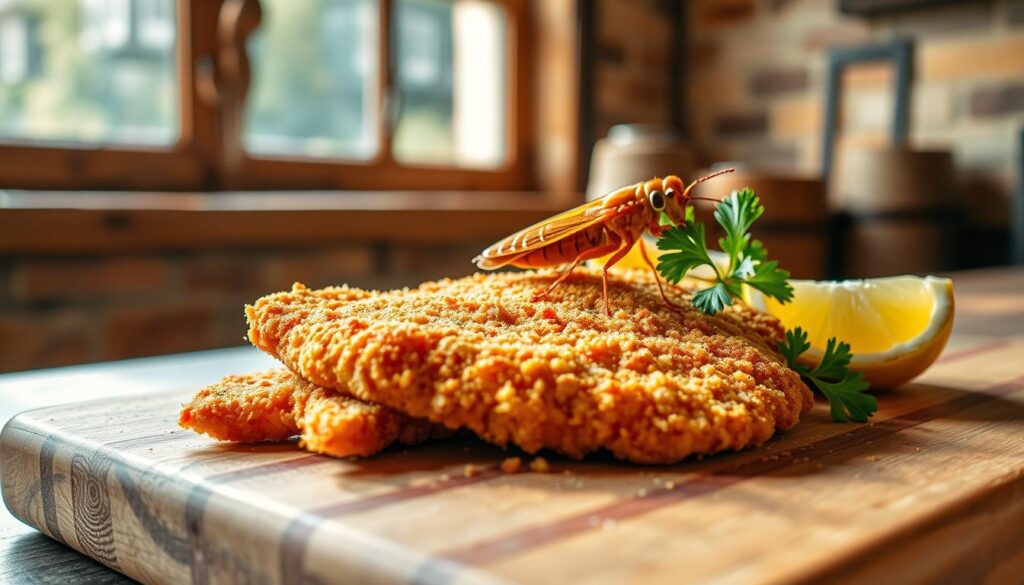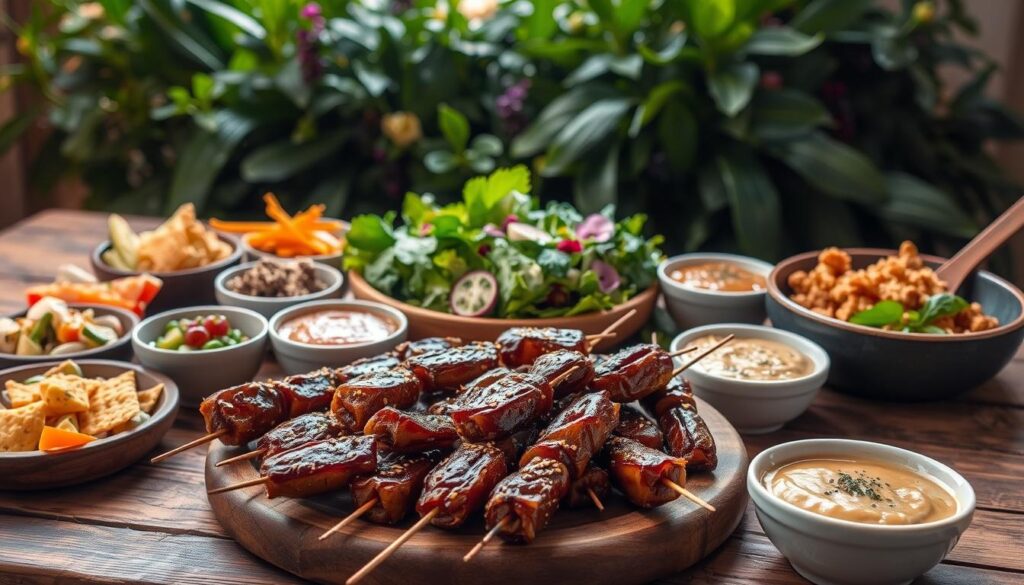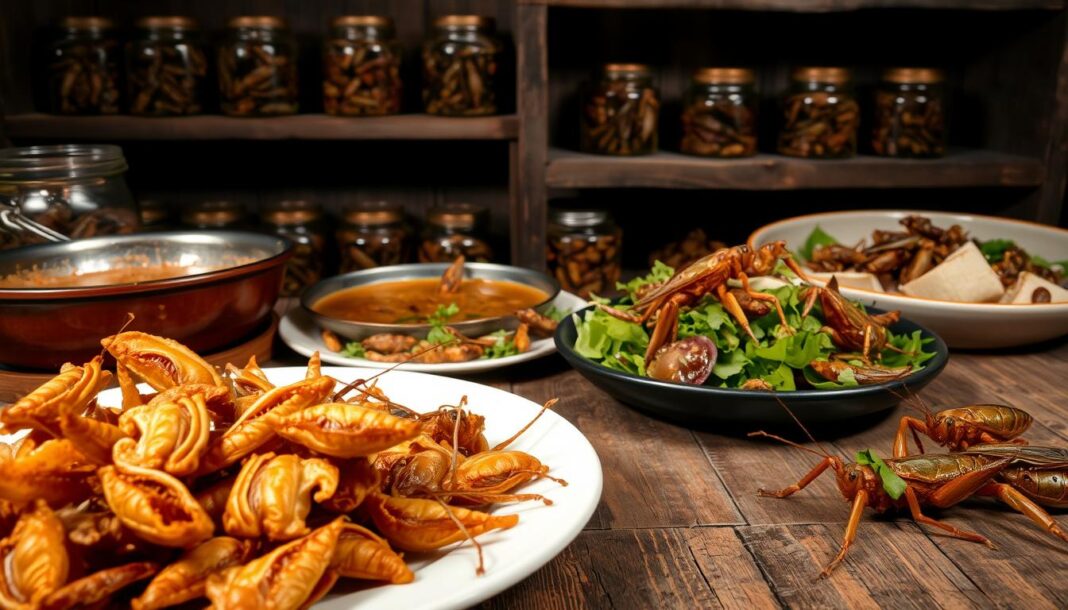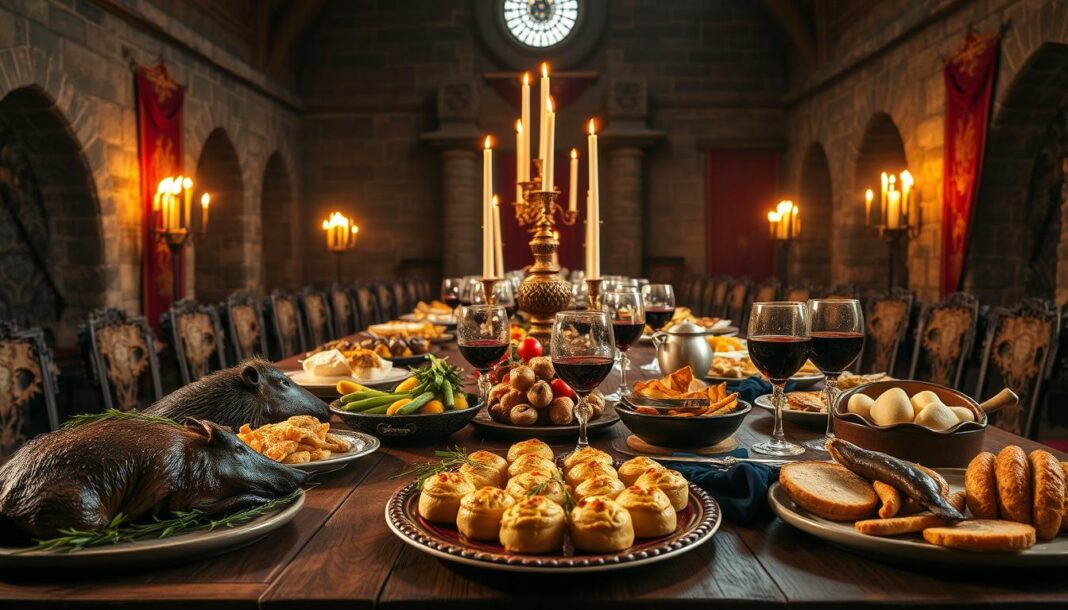At Historical Foods, we’re excited to introduce you to the fascinating world of entomophagy – the practice of eating insects. Locusts, in particular, offer a unique blend of nutritional benefits and sustainable food practices. In this article, we’ll explore the potential of locusts as a culinary ingredient.
We’ll be sharing our carefully tested recipe ideas that not only highlight the flavor and texture of locusts but also make them accessible to Western palates. From simple roasted locusts to more complex dishes, our guide aims to empower home cooks to experiment with this sustainable protein source.
Key Takeaways
- Discover the nutritional benefits of incorporating locusts into your diet.
- Learn how to prepare locusts using traditional techniques and modern culinary science.
- Explore a variety of locust-based dishes, from simple to complex recipes.
- Understand the sustainable aspects of entomophagy and its historical context.
- Gain confidence in cooking with locusts using our thoroughly tested recipes.
Why Locusts Are the Next Sustainable Protein
In the pursuit of sustainable eating, locusts stand out as an ecologically logical choice. We find that locusts offer numerous environmental benefits as a protein source.
Nutritional and Ecological Advantages
Locusts are not raised; they’re foraged, eliminating greenhouse emissions associated with their production. They serve as a healthier alternative to industrially produced snacks, requiring no packaging that could end up in landfills and coming in a convenient, bite-sized form.
- Locusts require significantly fewer resources than traditional livestock, using less land, water, and feed while producing minimal greenhouse gas emissions.
- With a protein content of up to 60% by dry weight, locusts are nutritionally comparable to beef but have a much smaller ecological footprint.
- Historically, people across various regions have incorporated locusts into their diets, demonstrating their viability as a sustainable food source.
By adopting locusts into our diets, we can enjoy a sustainable protein that’s both nutritious and environmentally friendly. This shift can significantly reduce our carbon footprint while maintaining adequate protein intake.
What Do Locusts Actually Taste Like?
Locusts have a unique flavor profile that is often described as mild and nutty, making them a versatile ingredient in various recipes.
Culinary Characteristics of Locusts
Our extensive taste tests have revealed that properly prepared locusts have a flavor profile often compared to sunflower seeds or roasted nuts. The taste can vary depending on their diet, with wild-harvested specimens carrying subtle herbal or grassy notes.
- Mild, nutty flavor profile
- Varying taste depending on diet
- Pleasant umami quality
Chef Moshe Basson notes that locusts taste “reminiscent of quail” with notes similar to sunflower seeds and shrimp. The flavor compounds in locusts are concentrated when dried, creating a more intense taste experience.
| Preparation Method | Flavor Profile | Texture |
|---|---|---|
| Roasted | Nutty, slightly sweet | Crunchy exterior, firm interior |
| Dried | Concentrated, intense | Crunchy |
Preparing Locusts for Cooking
The key to cooking delicious locusts lies in their preparation. As Basson noted, “They’re more appetizing if you pull off the head, the short legs, and wings. The long legs are relatively plump, like chicken legs.”
Effective Techniques for Locust Preparation
To prepare locusts, we start with frozen ones, which are easier to handle and ensure any potential pathogens are eliminated. The first step involves removing the heads, wings, and smaller legs by gently twisting the head and pulling off the unwanted appendages.
- Parboiling locusts for 2-3 minutes in lightly salted water helps clean them further and prepares them for subsequent cooking methods.
- After parboiling, locusts should be thoroughly dried before being tossed with oil and salt or other seasonings to ensure they crisp properly when roasted or fried.
- When developing a recipe, we’ve found that leaving the long hind legs intact can result in a more pleasing texture, as they contain more meat and become crunchy when cooked.
For those new to cooking with insects, we recommend starting with pre-cleaned locusts from reputable suppliers. This simplifies the preparation process and ensures a safe and enjoyable culinary experience.
Crispy Roasted Desert Locusts
Roasting desert locusts brings out their natural flavors and gives them a satisfying crunch. We prefer to use the sub-adult (3rd instar) stage of the desert locust for this recipe due to their ideal balance of tenderness and flavor.
Simple Roasting Technique
To prepare the locusts, we first remove their legs and wings. Then, we toss them in a mixture of high-quality olive oil, sea salt, and roasted garlic powder to give them a classic flavor profile.
The seasoned locusts are then arranged in a single layer on a baking sheet and roasted in the oven at 350°F (170°C) for 10-12 minutes, or until they turn a golden brown color and become delightfully crisp.
- For this recipe, we recommend using sub-adult locusts or grasshoppers (3rd instar stage) as they offer the best balance of tenderness and flavor.
- Adding a pinch of smoked paprika or cumin to the seasoning mix can create depth of flavor that complements the natural nuttiness of the locusts.
- This simple recipe is an excellent introduction to entomophagy, making it approachable for curious eaters.
The roasted locusts can be served as a protein-rich snack, a unique appetizer, or used as a crunchy topping for salads and soups, making them a versatile ingredient in various dishes.
Chef Basson’s Crisp Grasshopper Recipe
In this section, we share Chef Moshe Basson’s renowned Crisp Grasshopper recipe, a dish that has delighted diners at his high-end Jerusalem restaurant, Eucalyptus.
A Chef’s Approach to Locusts
To prepare Chef Basson’s Crisp Grasshoppers, start by parboiling about 25 locusts in 2 liters of vegetable stock infused with turmeric for 3 minutes. This step not only cleans the locusts but also subtly flavors them.
After parboiling, drain the locusts and let them cool. Then, twist off their heads to remove the black, threadlike viscera, and take off the wings and small legs for a more appealing presentation.
The next step involves creating a seasoned flour mixture using 4 tablespoons of flour, 3/4 teaspoon salt, a pinch of pepper, chili powder, ground coriander, and dried garlic granules. Roll the pre-cooked locusts in a beaten egg and then coat them in the seasoned flour.
| Ingredient | Quantity | Purpose |
|---|---|---|
| Locusts | 25 | Main ingredient |
| Vegetable stock | 2 liters | Parboiling |
| Turmeric | A pinch | Flavoring |
| Flour | 4 tablespoons | Coating |
| Salt | 3/4 teaspoon | Seasoning |
| Olive oil | For frying | Cooking |
Fry the coated locusts in oil for 1½-2 minutes, until they turn golden brown. This recipe yields crispy locusts with a flavorful coating, making it an appealing dish even for skeptical diners.
The result is a gourmet appetizer that combines the unique texture and flavor of locusts with a crispy exterior, seasoned with salt and spices.
Locust Schnitzel – A Familiar Twist
Our take on Locust Schnitzel blends traditional cooking techniques with modern entomophagy, making insects more approachable by presenting them in a familiar format.
Adapting Traditional Recipes
To prepare this dish, start by cleaning grasshoppers and lightly seasoning them with salt and garlic powder. Then, coat them using the classic three-step breading process: first in flour, then in beaten egg, and finally in seasoned breadcrumbs.
When frying, maintain the oil at a consistent 350°F (175°C), using enough oil to submerge the breaded locusts completely. This ensures even cooking and optimal crispness. Serve with a lemony tahini sauce or a bright za’atar pesto to complement the mild flavor of the locusts.

This recipe demonstrates how traditional culinary techniques can be applied to novel ingredients, creating a bridge between familiar comfort foods and sustainable protein sources.
Adventurous Locust Tacos
By incorporating roasted locusts into traditional Mexican-inspired tacos, we’re creating a unique dining experience that’s both adventurous and sustainable.
Fusion Cuisine with Insects
Our fusion recipe begins with sautéing finely diced onion and minced garlic in a tablespoon of neutral oil until translucent, creating an aromatic base for the taco filling.
We then combine these sautéed aromatics with ground roasted locusts, which provide a protein-rich element with a pleasant nutty flavor that complements traditional taco seasonings.
The seasoning blend includes cumin, ground chili, and a pinch of salt, which harmonize with the natural flavors of the locusts while creating a familiar taco profile.
To serve, we recommend filling small corn tortillas with the locust mixture and topping them with fresh cilantro, a squeeze of lime juice, and a simple cabbage slaw for texture contrast.
For an authentic touch, consider adding chapulines (Mexican grasshoppers) alongside your locusts, which are traditionally prepared with garlic, lime, and chili—flavors that work equally well with desert locusts.
| Ingredient | Quantity | Preparation Method |
|---|---|---|
| Onion | 1 medium | Finely diced |
| Garlic | 2 cloves | Minced |
| Neutral Oil | 1 tablespoon | Sautéing |
| Ground Roasted Locusts | 1 cup | Combined with sautéed aromatics |
| Cumin | 1 teaspoon | Mixed with ground chili and salt |
| Ground Chili | 1/2 teaspoon | Mixed with cumin and salt |
| Salt | To taste | Added to seasoning blend |
| Corn Tortillas | 8-10 | Filled with locust mixture |
| Fresh Cilantro | Chopped | Used as topping |
| Lime Juice | 2 tablespoons | Squeezed over filling |
| Cabbage Slaw | 1 cup | Used as topping |
This recipe demonstrates how insects can be incorporated into diverse culinary traditions, making them more accessible to those new to entomophagy through familiar flavor profiles.
Gourmet Accompaniments for Locust Dishes
As we explore the world of entomophagy, the importance of gourmet accompaniments becomes increasingly evident. We’ve developed several gourmet accompaniments that elevate locust dishes from novelty to culinary excellence, helping people appreciate insects as legitimate ingredients.
Elevating Insect Cuisine
Our wild garlic emulsion, made with neutral oil, blanched wild garlic leaves, and precisely measured salt, pairs beautifully with roasted locusts. For a Mediterranean-inspired accompaniment, we recommend a smoky baba ganoush made with fire-roasted eggplant, tahini, lemon juice, garlic, and a touch of ground cumin.
A simple yet effective dipping sauce can be made by combining Greek yogurt with finely minced fresh herbs, a small amount of grated onion, olive oil, and salt. For those seeking bold flavors, our harissa-inspired hot sauce incorporates rehydrated dried chilies, roasted red peppers, garlic, ground caraway and coriander seeds, and olive oil.

Taking the Leap into Entomophagy
As we explore the world of entomophagy, it’s essential to start with the right ingredients. To make this transition smoother, we recommend beginning with locusts that have been professionally raised for human consumption, ensuring they’re free from pesticides and properly processed.
Practical Tips for Beginners
- Incorporate ground locusts into familiar recipes like burgers or meatballs for a gentle introduction.
- Pair locust-based dishes with familiar flavors like onion and garlic to create a bridge to acceptance.
- Start with small portions and simple preparations, allowing people to experience the flavor and texture without feeling overwhelmed.
Allocate at least 30 minutes for your first cooking experience with locusts. Consider using infused oils, such as locusts steeped in olive oil, as a gateway ingredient. By doing so, you’ll be joining a global culinary tradition practiced by approximately 2 billion people worldwide.


